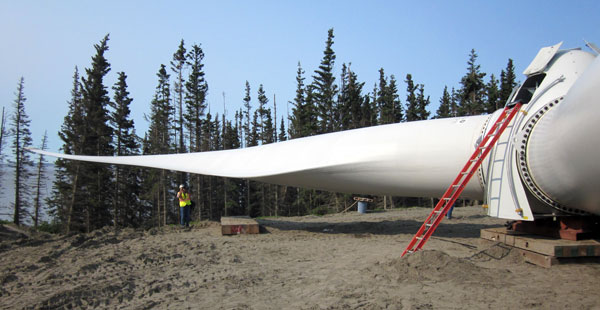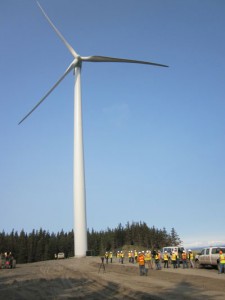
Updated Sept. 26 at 3:00 p.m.
Update from Chugach Electric spokesman Phil Steyer:
“Recent reporting on the Fire Island wind project has not been precise in reporting the wind as a percentage of sales.
Chugach has both wholesale and retail customers. Retail customers are those individual residences and commercial properties served by a utility. Wholesale customers are other utilities that purchase power from Chugach for sale to their own retail customers.
In 2011, 57 percent of the kilowatt-hours Chugach sold went to wholesale customers and 43 percent to Chugach retail customers. Power from Fire Island will go to meet the needs of Chugach’s retail customers only. Therefore, a statement like the following (with amendment in red) is correct.
It’s estimated the project will provide 4 percent of Chugach Electric Association’s power for its retail customers.”
All 11 wind turbines on Fire Island are now generating power for Southcentral Alaska. Officials at Cook Inlet Region Incorporated say they’ve been testing the turbines and transmission lines for nearly a month now. And today it became official – all of them are feeding into the grid.
If the wind is blowing, from now on when you look out across Cook Inlet from Anchorage, you might be able to see them spinning, all 11 of them. The wind turbines on Fire Island are providing the first source of renewable wind energy for Alaska’s largest city and surrounding areas.
Suzanne Gibson is vice president of Fire Island Wind and the senior director of energy development for Cook Inlet Region Incorporated, the Native Corporation that built the wind farm. She says CIRI completed construction in mid-August but they’ve been tying up details since.

“So it’s sort of a check list of things that we’ve had to accomplish in order to reach this date and we felt like were there on Friday and so we submitted a certificate of commercial operation to Chugach on Friday, which makes today sort of the contractual affective date that we began commercial operations with our buyer,” Gibson said.
The buyer is Chugach Electric Association. At the beginning, the cost of the wind power will be more expensive than gas they use to generate most of their power now. Chugach power costs, on average, 6 cents per kilowatt hour. At the start the wind power will be 3.7 cents more. The project has been in the works since the 90s, when a study identified Fire Island as the best place in the area to capture the wind power. And during the recent windstorm, Gibson says nature proved her point a little too strongly.
“The wind speeds were so high over on Fire Island that the turbines actually cut out,” she said.
But Gibson says there was no damage to the turbines during the storm. The turbines are manufactured by General Electric. They tower a hundred feet taller than the Conoco Phillips building, the city’s tallest building. Chris Rose is with the Renewable Energy Alaska Project, or REAP, a non-profit whose mission is to facilitate the increased development of renewable energy in Alaska. He says with gas prices expected to rise, wind power will be a money saver.
“Wind power is a very mature resource around the world,” Rose said. “And for us to finally be getting it in the Anchorage area is a boon, because I think people understand now more that it is something that is happening other places, it’s not something that is going to happen in the future.”
It’s estimated the project will provide 4 percent of Chugach Electric Association’s power, or enough electricity to power about 4,000 homes along the Railbelt. Rose points out that Iowa started out much the same way as Alaska, but now supplies about 20 percent of the state’s power via wind. Rose says he hopes Fire Island is just the beginning.
“I think this is the start of many other renewable energy projects that are going to be going into the Railbelt grid,” Rose said.
The turbines start producing power when the wind reaches 8 miles per hour. CIRI officials say the entire project cost $65 million to build, but state and federal grants are helping pay the bills. CIRI has permits to build 22 more of the wind turbines.
Daysha Eaton is a contributor with the Alaska Public Radio Network.
Daysha Eaton holds a B.A. from Evergreen State College, and a M.A. from the University of Southern California. Daysha got her start in radio at Seattle public radio stations, KPLU and KUOW. Before coming to KBBI, she was the News Director at KYUK in Bethel. She has also worked as the Southcentral Reporter for KSKA in Anchorage.
Daysha's work has appeared on NPR's "Morning Edition" and "All Things Considered", PRI's "The World" and "National Native News". She's happy to take assignments, and to get news tips, which are best sent via email.
Daysha became a journalist because she believes in the power of storytelling. Stories connect us and they help us make sense of our world. They shed light on injustice and they comfort us in troubled times. She got into public broadcasting because it seems to fulfill the intention of the 4th Estate and to most effectively apply the freedom of the press granted to us through the Constitution. She feels that public radio has a special way of moving people emotionally through sound, taking them to remote places, introducing them to people they would not otherwise meet and compelling them to think about issues they might ordinarily overlook.




